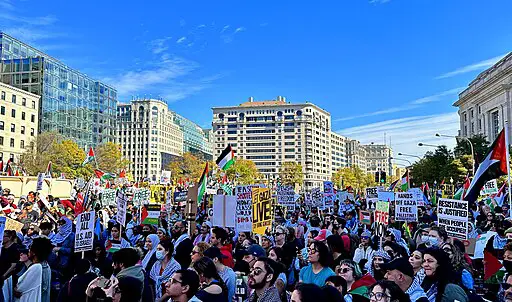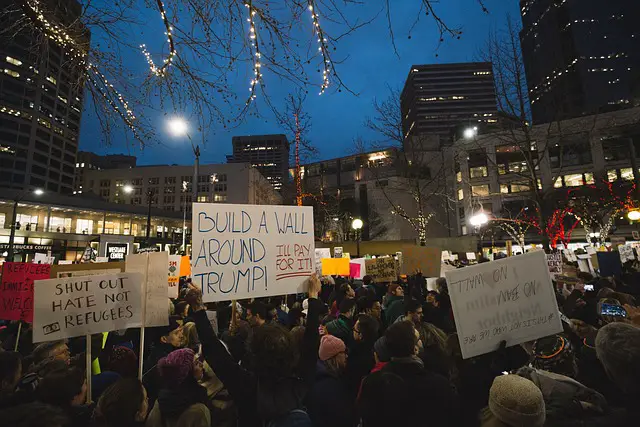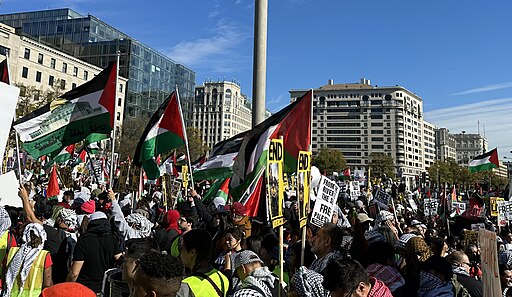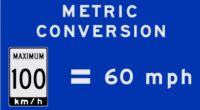A march is a procession of people on a route, while a rally is a gathering or meeting where people express their views or opinions.
TL;DR March Vs. Rally
A march is a form of protest where participants walk together in a coordinated manner to show solidarity and raise awareness for a particular cause or issue.
A rally is typically more focused on speeches and presentations that aim to inspire and motivate attendees towards action.
Definitions of a March

A march, in its essence, is a form of organized movement where individuals come together and walk collectively to demonstrate support for a cause or raise awareness about an issue. It involves participants walking in unison along a predetermined route, often carrying signs, banners, and chanting slogans. Marches can be peaceful expressions of solidarity or powerful acts of civil disobedience. They provide a platform for people to voice their concerns while visually showcasing the strength and size of their collective presence.
What sets marches apart is their focus on physical movement as a means of communication. The act of marching symbolizes forward progress and unity among participants who are united by a common goal or purpose. Whether it’s advocating for equal rights, protesting against injustice, or demanding policy changes, marches serve as dynamic displays of public opinion that capture attention both locally and globally.
Marches can vary in scale – from small-scale local gatherings to massive international events that draw crowds numbering in the hundreds of thousands. Regardless of size, marches create an atmosphere charged with energy and passion as like-minded individuals join forces to make their voices heard.
By taking our grievances to the streets through marches, we embody the power within ourselves to effect change collectively rather than relying solely on individual efforts behind closed doors. These demonstrations not only bring attention to important issues but also foster community engagement and promote dialogue surrounding social causes.
Definitions of a Rally

A rally is a gathering or assembly of people who come together to express their support for a particular cause or issue. It is often organized with the intention of raising awareness, generating public attention, and influencing decision-makers.
A rally is a form of mass protest that aims to bring about social change through collective action. Participants in a rally can range from activists and advocates to community members and concerned citizens. The size of a rally can vary greatly, ranging from small grassroots gatherings to large-scale events that attract thousands or even millions of people.
Rallies often feature speeches by influential individuals who champion the cause at hand. These speakers use their platform to inspire and mobilize participants, sharing personal stories, facts, and arguments to galvanize support for the cause.
In addition to speeches, rallies may also include music performances, chants, signs and banners as means of expressing solidarity and unity among participants. They are typically held in public spaces such as parks or city squares where they can garner maximum visibility and media coverage.
Rallies serve as powerful tools for collective action by harnessing the energy and passion of like-minded individuals who share common goals. They provide an opportunity for ordinary people to make their voices heard on issues that matter deeply to them.
March Vs. Rally – Key differences
| Aspect | March | Rally |
|---|---|---|
| Type of Event | A physical procession or parade, often with participants walking in a coordinated manner. | A gathering or assembly of people in one location for a specific purpose, often involving speeches or presentations. |
| Movement | Involves physical movement along a predetermined route, such as a street or public space. | Typically takes place in a stationary location, such as a park, square, or government building. |
| Communication | Participants convey their message through their presence and, sometimes, banners or signs. | Attendees express their views through speeches, presentations, and the display of signs or banners. |
| Purpose | Often used to raise awareness, show solidarity, or symbolically express a collective message or cause. | Allows people to listen to speakers, engage in discussions, and mobilize support for a specific issue or cause. |
| Engagement | Participants are actively involved by walking or marching, providing a physical presence. | Attendees participate by listening to speakers and engaging in discussions or activities at the stationary location. |
| Logistics | Requires planning for a specific route, coordination, permits, and considerations for the movement of participants. | Involves planning for speakers, permits, sound systems, and crowd management in a stationary setting. |
| Examples | Civil rights marches, parades, protest marches, pride parades. | Political rallies, public speeches, awareness rallies, protest gatherings. |
Examples of Famous Marches and Rallies
Marches
March on Washington for Jobs and Freedom (1963): Martin Luther King Jr.’s iconic “I Have a Dream” speech during this civil rights march is one of the most memorable moments in U.S. history.
Selma to Montgomery March (1965): Led by civil rights activists, this march aimed to secure voting rights for African Americans, resulting in the Voting Rights Act of 1965.
Salt March (1930): Mahatma Gandhi led this nonviolent protest against British salt taxes, a key event in India’s struggle for independence.
Women’s Suffrage Parade (1913): A pivotal event in the women’s suffrage movement, it took place in Washington, D.C., advocating for women’s right to vote.
Rallies:
Free Palestine: “Free Palestine” marches and rallies are organized events held worldwide to express solidarity with the Palestinian people and to protest various aspects of the Israeli-Palestinian conflict, including issues related to the Israeli occupation, human rights violations, and the call for an independent Palestinian state. These events often feature speakers, banners, signs, and demonstrations to raise awareness and advocate for change in the region. The “Free Palestine” movement has gained prominence as a global symbol of support for the Palestinian cause.
Vietnam War Protests (various years): Mass rallies across the U.S. opposed the Vietnam War, leading to widespread anti-war sentiment.
Black Lives Matter Protests (ongoing): A global movement protesting racial injustice and police brutality, sparked by the killing of George Floyd in 2020.
Climate Change Marches (various years): Global rallies, like the 2019 Global Climate Strike, call for climate action and environmental preservation.
Image Credits
Featured Image By – APK, CC BY 4.0, via Wikimedia Commons
Image 1 By – APK, CC BY 4.0, via Wikimedia Commons








